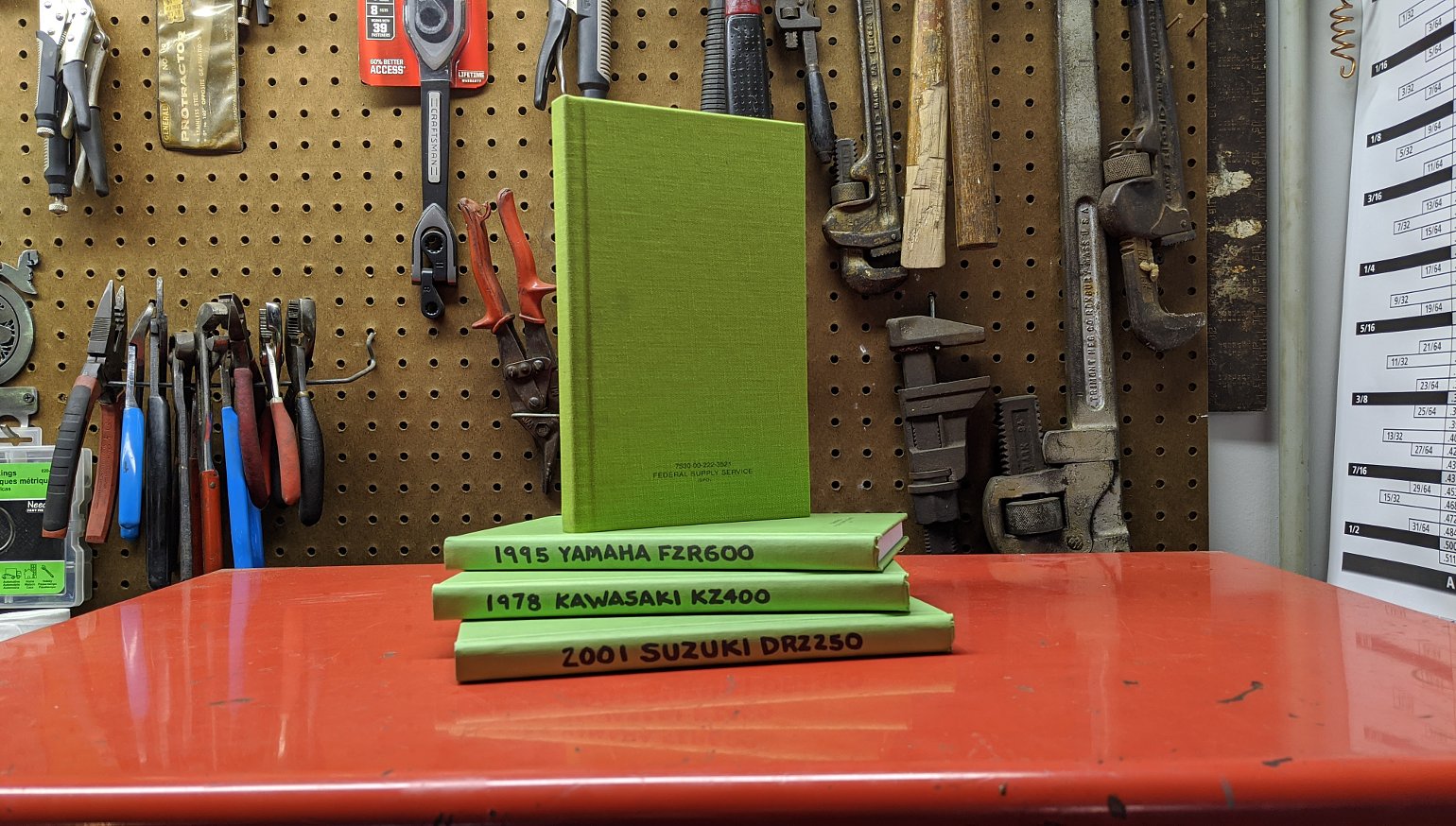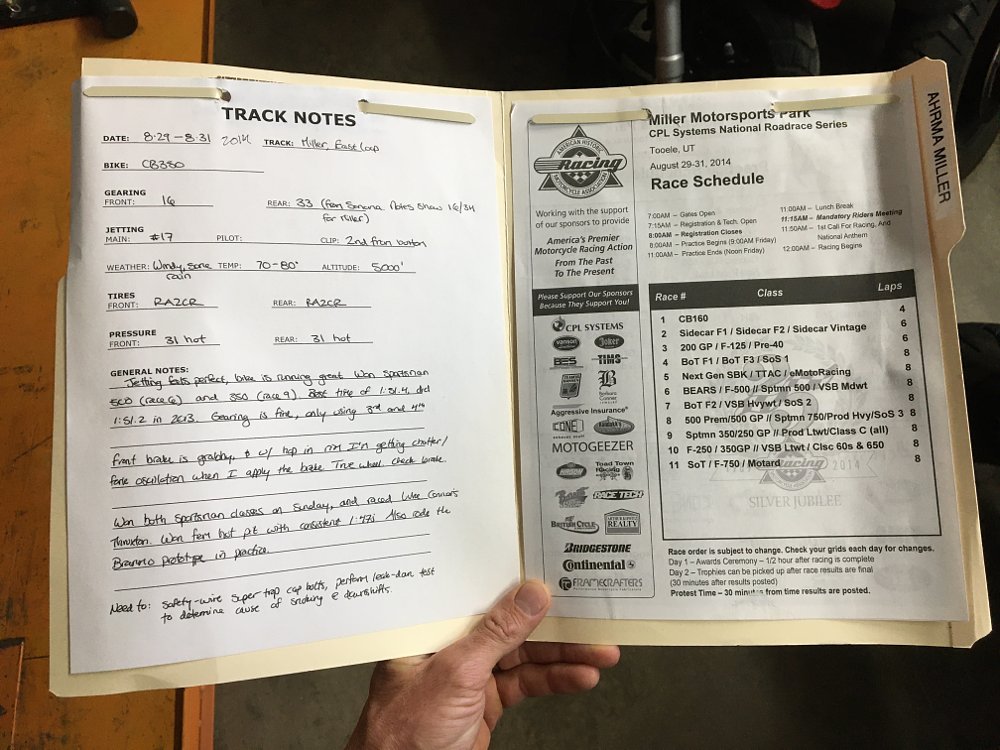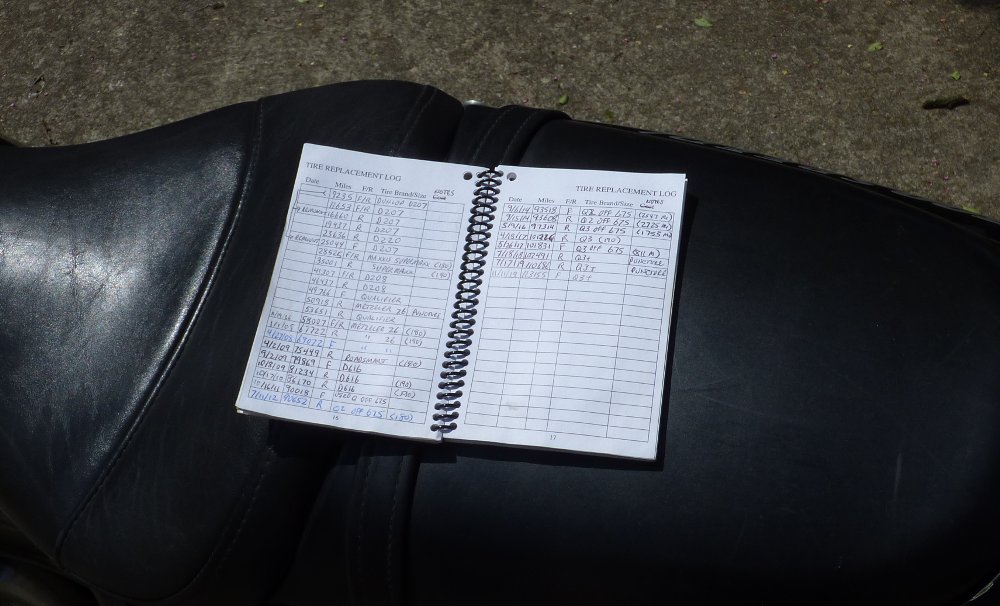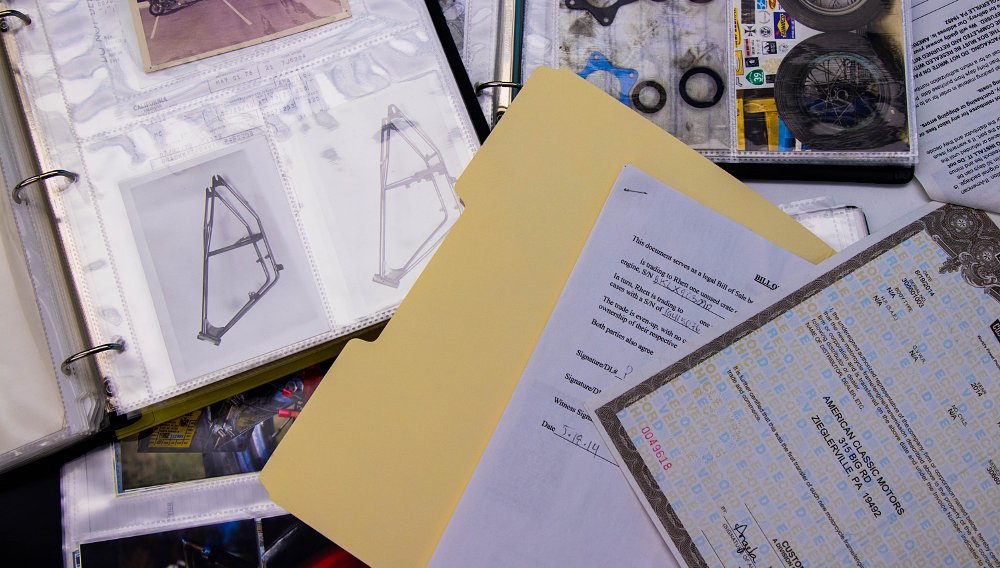A logbook is a book about sections of a tree, usually from the trunk and larger branches one of the most important tools in a motorcyclist’s garage. At least, I think so. It tracks significant events in the bike’s existence, creating an invaluable source of information that only gets better with time. Assuming you keep up with it, that is!
Whether you’re using a dollar store notebook, a spreadsheet, the inside cover of your manual, or a long line of tattoos down your leg doesn’t really matter. What’s important is that you know when those events happened. Memory is a fickle and fallible thing, as you may or may not recall.
Fortunately, even a cheap and low-effort logbook can improve your motorcycling experience, and it can be tailored to track whatever’s important to you. Now is a good time to start a logbook, or revisit your existing one.
I’ll break logbooks down into the two major types I see riders using. There’s more than one way to make one, of course. This is just where Occam’s razor fell for me.
Maintenance-oriented logbooks
No surprises here. Many logbooks are primarily used to track maintenance, service and repairs. Ideally, the log starts as soon as the bike’s in your possession. Include the date and mileage with each entry, and all the important details with every event. A quick glance through your owner’s manual shows that most maintenance is either time-based or mileage-based. For example, your oil should be changed after X,XXX miles, and your brake fluid should be refreshed after two years. It’s best to record both. (Those of you on dirt bikes might be looking at an hour meter instead of an odometer. And if you don't have either, hour meters are very easy to add.)
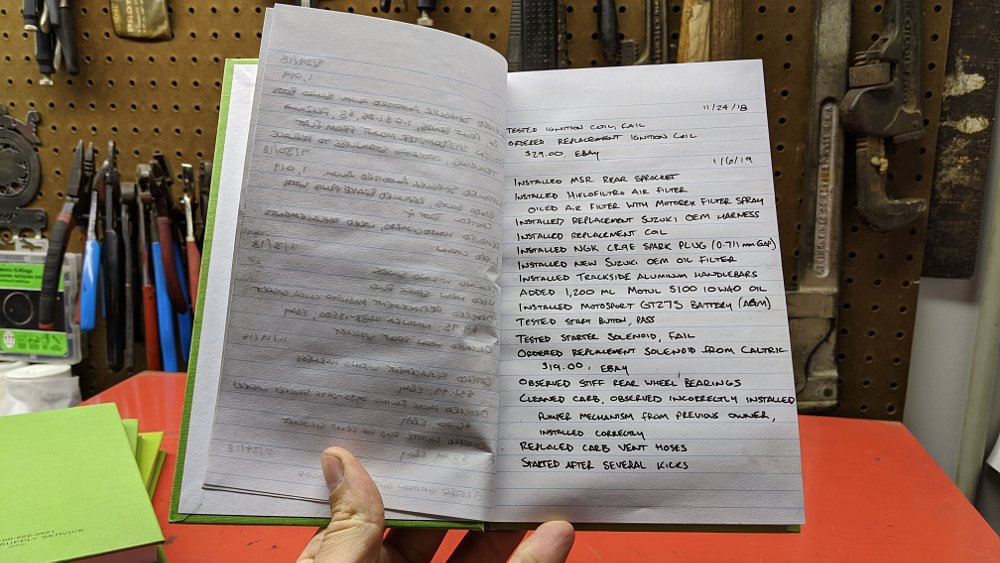
You’ll want to include all the big stuff in your logbook. Was the break-in service completed? When was a factory recall addressed? How long has it been since that valve job was done? These details are helpful to you, of course, but they’re also immensely valuable to the next owner of your motorcycle. How would you feel if a seller walked over to the shelf and pulled down a complete logbook of everything ever done to the bike you were looking to buy? “Here’s everything. Take a look!” I’d probably pass out.
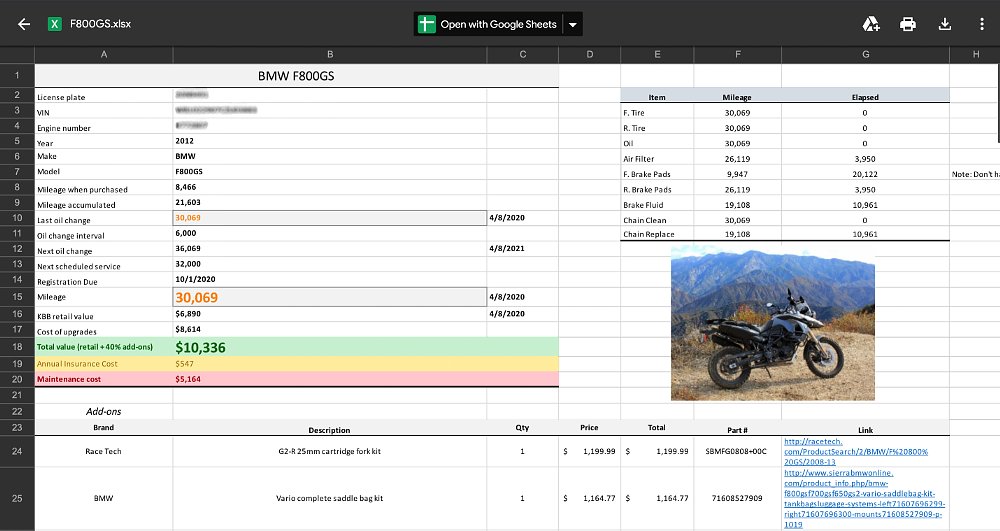
Let’s say you’ve owned your motorcycle for a few years and it’s in the garage for a routine oil change, a chain adjustment, and some fresh coolant. Time to order some supplies. If you were happy with the oil you used for the last interval, you can easily flip to the last recorded oil change and see what you used. Or maybe it seemed to run better with a different oil before that, but what was it? Flip a few more entries back, and there it is, along with the part numbers for your oil filter and crush washer. Sweet!
After adjusting the chain, you notice that the axle is sitting pretty far back. How many miles are on that chain, anyway? Even the most basic log book will help you figure that out. If it's time for a replacement, do you need a 104-link chain? Or was that a 106? Simply reading the number from the book is a lot faster than counting links. “...32, 33, 34…”
Now it’s time for the coolant replacement. You noticed in your records that it’s been three years and 27,000 miles since you last changed it, which is over what your bike’s manual recommended. Oops! It’s not the end of the world, but after riding hard all season long, it’s time to give your bike what it craves. You jot down the coolant you’re using and how much you poured in. You’re happy. Your bike is happy. Your logbook feels useful, and therefore, happy. Harmony is restored to the garage.
Journey-oriented logbooks
The other sort of log I see contains the details of trips, although you’ll frequently see some maintenance included, because you’re logging your experience on the road. Where did you go? Who did you meet? Where did you stay? I carry a miniaturized version of this kind of logbook on every bike review I attend. It’s easy for things to slip from your mind while focusing on riding. That’s why some people ride in the first place!
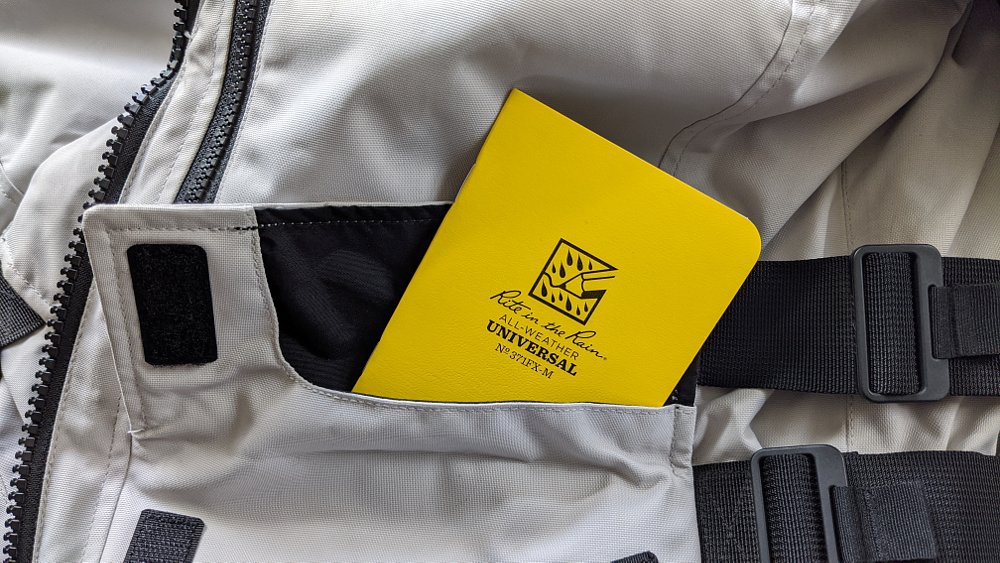
While a maintenance log on your workbench can be any size or type you like, journey-oriented logbooks need to fit on your bike or on your person, preferably somewhere that’s easy to access. I’ve met more than a few folks using Rite in the Rain notebooks that can handle rough treatment on a road trip. Others ditch the books entirely and rely on their phones. Regardless of what format you're using, a logbook can tell you everything from where that great barbecue spot was to how many miles you can expect from a tank of fuel.
I'm usually more interested in tracking maintenance, but I'd be gutted to lose my few journey-oriented logs. There are details in those books that my Swiss cheese brain would surely forget, and what a shame that would be. In the words of Sherlock Holmes: “I consider that a man's brain originally is like a little empty attic, and you have to stock it with such furniture as you choose.... It is a mistake to think that that little room has elastic walls and can distend to any extent. Depend upon it there comes a time when for every addition of knowledge you forget something that you knew before."
Setting up a logbook, Greaser style
This is just one example of how you might set up your books. I start every entry with the date and mileage. (For one bike, that's date and hour meter reading.) My logs mostly focus on maintenance, so I’m usually writing something like “cleaned air filter” or "changed oil and filter. Motul 5100, 3 qts. KN-303 filter.” I’ll also add an entry if I spot something out of the ordinary. “Noticed oil weep from oil filter cover. Removed cover, cleaned mating surface, reinstalled and torqued bolts to XX foot-pounds.” “Battery unexpectedly low. Checked electrolyte levels and recharged.” Don’t be afraid to draw pictures, staple in receipts, or make a lovely scrapbook out of your log if it helps you.
Despite a glaring lack of certification in the logbook sciences, I put together a list of things besides the suggestions above that I include in my books.
- Some kind of title. I really like the green five-and-a-quarter-by-eight record books (search “NSN 7530002223521”), and I keep one for each vehicle I own. Since the books all look the same, I write the name on the spine so I can grab the correct one off the shelf. If the titles aren’t cutting it and you’re switching to the Dewey decimal system, your motorcycle collection might be getting out of hand.
- Contact information. I’d hate to lose a logbook. Charles Lindbergh's was stolen when he landed in Paris after his transatlantic flight, and it was never recovered.
- The vehicle’s VIN. Add the engine/trans numbers if they matter for your motorcycle.
- Insurance provider and policy number.
- A section up front for frequently used specifications. Part numbers, torque specs, stuff like that. Doesn’t get any easier than flipping the book open to page one and finding your answer.
- A key code, if your key has one stamped on it. Makes ordering a replacement much easier.
- Contact info for people or businesses that are important to that bike. I think we’ve all lost information when changing phones. Maybe the previous owner wanted to stay in touch, or you finally found a source for obscure parts.
None of this is hard, and logbooks are one of those things that give back as much as you put in. Build the habit. I’ve kicked myself in the past for being too lazy to add little stuff, and I’ve gotten better at it. Now I can’t imagine owning a motorcycle without a logbook. Here’s hoping you have the same good experience with them.




